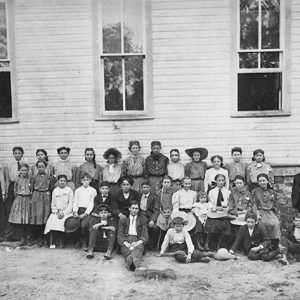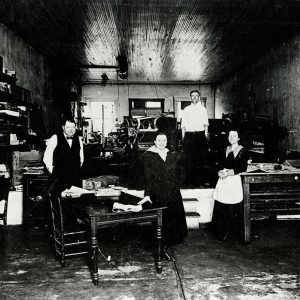calsfoundation@cals.org
Huntington (Sebastian County)
| Latitude and Longitude: | 35°04’56″N 094°15’48″W |
| Elevation: | 636 feet |
| Area: | 0.67 square miles (2020 Census) |
| Population: | 490 (2020 Census) |
| Incorporation Date: | February 4, 1888 |
Historical Population as per the U.S. Census:
|
1810 |
1820 |
1830 |
1840 |
1850 |
1860 |
1870 |
1880 |
1890 |
1900 |
|
– |
– |
– |
– |
– |
– |
– |
– |
913 |
1,298 |
|
1910 |
1920 |
1930 |
1940 |
1950 |
1960 |
1970 |
1980 |
1990 |
2000 |
|
1,700 |
1,453 |
813 |
863 |
744 |
560 |
627 |
662 |
715 |
688 |
|
2010 |
2020 |
|
|
|
|
|
|
|
|
|
635 |
490 |
|
|
|
|
|
|
|
|
Huntington is a second-class city located in the coal-rich Arkansas River Valley of southern Sebastian County. Its fortunes rose and fell with the coal industry, but the city has revived in the twenty-first century, billing itself as a location with “quiet, comfortable, and affordable living.”
Situated about twenty-five miles south of Fort Smith (Sebastian County), the land that would become the city of Huntington was purchased around 1888 by Levi Barrett, who almost immediately sold the land to the Missouri, Kansas, and Texas Coal Company. Samuel Fellows had already begun a coal mine at nearby Cherokee Creek in June 1887 and had built a house on the hillside claimed by Barrett that same month. In time, three large coal mines were operating in the immediate area. The company laid out a city for its workers on the hillside, naming the new city Huntington after a mine superintendent who had died in the area when the horse he was riding jumped off a bridge. The new city included several stores (including a company store of 7,680 square feet, one of the largest in the state), saloons, dance halls, boarding houses, restaurants, barber shops, hotels, churches, and a jail. A school district had already been established by 1887; the first school building was a two-story wooden structure, but it later was replaced by a three-story brick building. Late in the nineteenth century, Huntington had three newspapers: the Huntington Hummer, the Herald, and the Democrat.
Many of the miners working in Huntington were African American. A strike in 1899 led the company to bring in black workers from other states, but strike leader George Bunch (himself an African American) declared that “these Negroes who had come from other states should be burned, as they knew that the strike was on before they came to Huntington.” Most of the strikebreakers left the area, and the work stoppage was eventually resolved. Unlike other coal mining areas of Sebastian County, though, Huntington did not become a “sundown town” but remained racially diverse. A successful black baseball team, the Huntington Bearcats, played from thirty to thirty-five games a year against teams from Arkansas and Oklahoma in the early twentieth century, winning more than they lost each season.
Huntington was the home of Dan Hogan, a leader in the state’s Socialist Party, as well as his daughter, activist Freda Hogan Ameringer. As a teen, Ameringer wrote for her father’s newspaper, the Herald, and later took part in labor organizations and in the battle for women’s suffrage.
An opera house called the Majestic opened in Huntington around 1913, hosting vaudeville and other traveling acts as well as plays put on by local drama groups. Movies were later shown at the Majestic, but when it burned down in March 1929, it was not replaced. By the beginning of the Depression, the coal industry of Arkansas was already in decline, and the population of Huntington dropped steadily. The school district was consolidated with that of Mansfield (Sebastian and Scott counties) in 1962, and the three-story school building in Huntington was demolished.
Kenneth Elmore, elected mayor of Huntington in 1970, resolved with the help of the city council and other citizens to revive the failing city. They began by remodeling the city hall—cleaning and painting the walls, leveling the floors, and adding paneled walls to create new office space and meeting space.
As of 2012, Huntington has six churches—two Baptist congregations, an Assembly of God, a United Methodist church, a Pentecostal church, and a New Life Tabernacle. The city’s business directory lists sixteen businesses, including automotive services, hair care services, a day care and pre-school, and a Farmers Bank. According to the 2010 census, most of the 635 residents of Huntington are white. The Old Huntington jail was added to the National Register of Historic Places in 2008.
For additional information:
Anderton, Pattie. “Huntington City Hall.” The Key 9 (Spring 1974): 27.
———. “The Huntington Opera House.” The Key 9 (Spring 1974): 6.
“The Huntington Bearcats.” The Key 9 (Spring 1974): 26.
Moore, Jerry H., and Lonnie C. Roach. No Smoke, No Soot, No Clinkers. N.p.: 1974.
Steven Teske
Butler Center for Arkansas Studies
 Huntington Band
Huntington Band  Huntington Meat Market
Huntington Meat Market  Huntington School
Huntington School  Huntington Mine Workers
Huntington Mine Workers  Huntington Motel
Huntington Motel  Huntington Newspaper
Huntington Newspaper  Huntington Street Scene
Huntington Street Scene  Sebastian County Map
Sebastian County Map  UMWA Document
UMWA Document 



Comments
No comments on this entry yet.